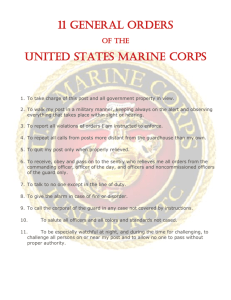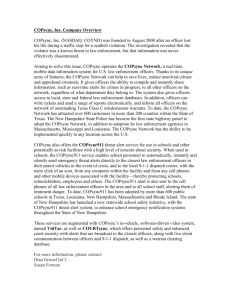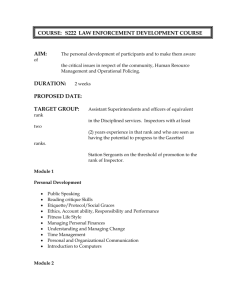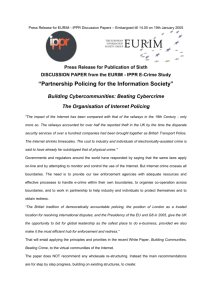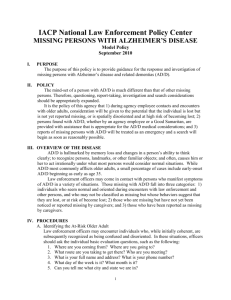bus661-week_3-discussion_questions
advertisement
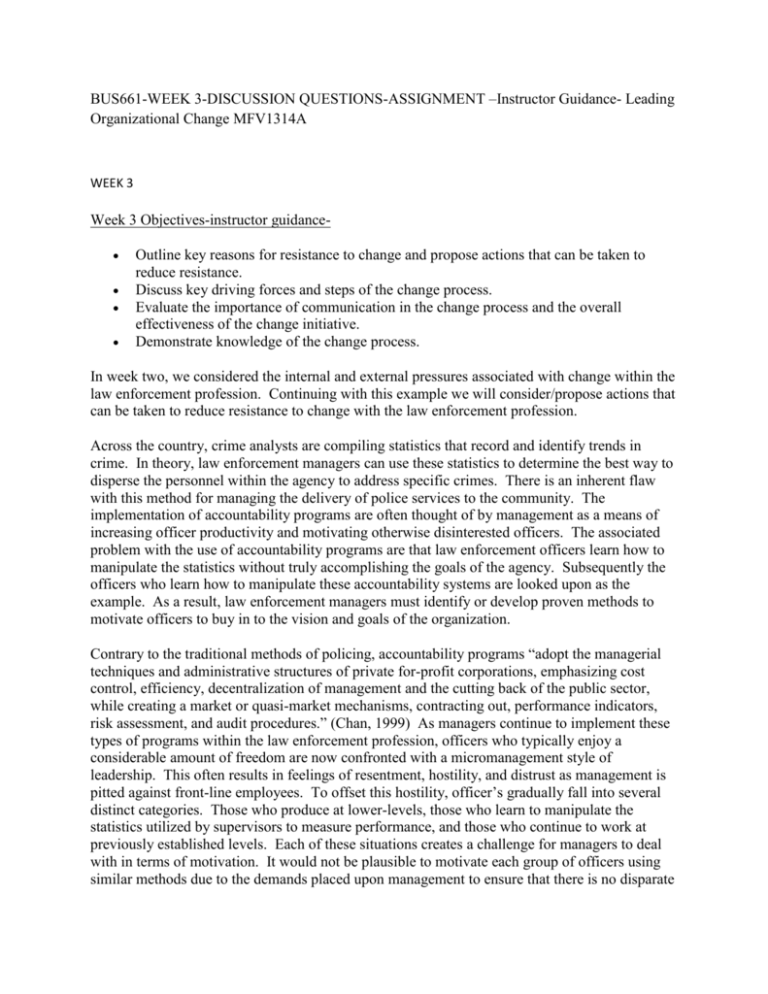
BUS661-WEEK 3-DISCUSSION QUESTIONS-ASSIGNMENT –Instructor Guidance- Leading Organizational Change MFV1314A WEEK 3 Week 3 Objectives-instructor guidance Outline key reasons for resistance to change and propose actions that can be taken to reduce resistance. Discuss key driving forces and steps of the change process. Evaluate the importance of communication in the change process and the overall effectiveness of the change initiative. Demonstrate knowledge of the change process. In week two, we considered the internal and external pressures associated with change within the law enforcement profession. Continuing with this example we will consider/propose actions that can be taken to reduce resistance to change with the law enforcement profession. Across the country, crime analysts are compiling statistics that record and identify trends in crime. In theory, law enforcement managers can use these statistics to determine the best way to disperse the personnel within the agency to address specific crimes. There is an inherent flaw with this method for managing the delivery of police services to the community. The implementation of accountability programs are often thought of by management as a means of increasing officer productivity and motivating otherwise disinterested officers. The associated problem with the use of accountability programs are that law enforcement officers learn how to manipulate the statistics without truly accomplishing the goals of the agency. Subsequently the officers who learn how to manipulate these accountability systems are looked upon as the example. As a result, law enforcement managers must identify or develop proven methods to motivate officers to buy in to the vision and goals of the organization. Contrary to the traditional methods of policing, accountability programs “adopt the managerial techniques and administrative structures of private for-profit corporations, emphasizing cost control, efficiency, decentralization of management and the cutting back of the public sector, while creating a market or quasi-market mechanisms, contracting out, performance indicators, risk assessment, and audit procedures.” (Chan, 1999) As managers continue to implement these types of programs within the law enforcement profession, officers who typically enjoy a considerable amount of freedom are now confronted with a micromanagement style of leadership. This often results in feelings of resentment, hostility, and distrust as management is pitted against front-line employees. To offset this hostility, officer’s gradually fall into several distinct categories. Those who produce at lower-levels, those who learn to manipulate the statistics utilized by supervisors to measure performance, and those who continue to work at previously established levels. Each of these situations creates a challenge for managers to deal with in terms of motivation. It would not be plausible to motivate each group of officers using similar methods due to the demands placed upon management to ensure that there is no disparate treatment among the officers. Additionally, unions and contracts can add to the complexity of the problem of appropriately motivating officers. Therefore, law enforcement agencies should allocate a significant amount of its resources toward developing good motivational tools to enhance officer productivity. This begs the question, how can motivation be accomplished while maintaining organizational integrity, efficiency, and productivity? It has become apparent that traditional disciplinary and reward systems do not go far enough to motivate officers on a continual basis. Further, accountability programs implemented by agencies such as the Broward Sheriff’s Office (BSO) are subject to corruption and statistical manipulation by both command staff as well as road deputies/officers. Developing motivational strategies for officers will ultimately assist the law enforcement agency in attaining its goals, as well as to increase officer morale and performance. The positive changes within the law enforcement agency will be reflected in the community response to the local policing agency. With the advent of community policing throughout the United States, law enforcement has redefined its roll within the community. Quite simply, police departments are now aligning to crime prevention initiatives rather than the traditional reactive mode which was dependent on the counting of citations written and the total number of arrests. With this philosophy and initiative in mind, ironically, it may be far more productive for the police manager and community, as a crime prevention tactic, to simply park an unoccupied marked patrol car in a high crime area compared to the alternative of having a non-productive employee utilize that same car and intentionally avoid those areas where the high profile visibility is needed. Those employees failing to productively contribute to the needs of the community negatively impact the overall cost to the agency and its perception within the community. How then can law enforcement managers take on dead wood in a positive and aggressive manner to benefit the employee, the agency, and most important of all, the community? The initial approach by management in confronting non-productive employees must be positive. In the past, a line supervisor would be tasked to document low performance. This inevitably created a long term paper trail, which unfortunately, accomplished little if anything in the end. Action of this sort also lends itself to direct challenge by the employee in question as being a form of selected discipline and/or harassment. Management then is forced to assume a defensive role, which often becomes labor intensive and costly to the agency, once again, accomplishing little if anything in the end. The first step to be taken by management should be on of direct confrontation with the employee. Performance is not measured by the number of arrests or citations, but rather on prevention initiatives within the community. Statistical data needs to be provided to the employee showing that during that employee’s tour of duty and zone assignment, calls for service are constant and/or increasing. This could include all types of activity including traffic accidents, juvenile disturbances, and criminal reports taken on other shifts identifying times of occurrence as that of the subject employee’s assigned tour of duty. The employee’s past and current record now speaks for itself. At the time of the confrontation, which is now referred to as counseling by management, the employee should be permitted to have representation of their choosing present at the scheduled meeting. The employee quite simply is informed that their current level of performance is failing to meet the needs of both the community and the agency in relation to effective crime prevention initiatives. The employee is then presented with the statistical data previously discussed and then asked one question: Why are you failing to meet the need of the community and the agency? A direct response by the employee suggesting that they feel they are doing their job now provides the foundation for management to clearly show the employee where they are deficient in terms of the overall objectives of the agency in relation to community policing. The statistical data and documented performance of this employee now play a critical role in management’s attempt to turn this employee into a productive member of the department. If the employee accepts the counseling, retraining is initiated and formally monitored. If the employee is insistent that they are doing the job in spite of statistical data and overview of the agency’s current objectives, either way, the employee has now indicated that they do not know how to do their job. Having posed the aforementioned question to the non-productive employee, they may answer the question with one of three possible responses. 1. I refuse to do my job in order to meet the needs of the community and/or the agency. 2. I do not know how to do my job in relation to the current community needs and department expectations. 3. Personal problems are affecting my ability to do the job. Rarely will the employee answer with a direct refusal to do their job. This response lends itself to a direct act of insubordination, which allows for a clear case to justify termination. In the event the employee responds with the last option indicating personal problems, a command decision referral for the appropriate counseling is immediately initiated. The employee should be placed on immediate administrative suspension pending completion of counseling. If this is not immediately done, the agency is now at risk for any action lending itself to controversy, which was initiated by the employee in question. Reference Chan, J. B. L. (1999), Governing police practice: limits of the new accountability. The British Journal of Sociology, 50: 251–270. doi: 10.1111/j.1468-4446.1999.00251.x Week 3 Preview of Readings, Discussions, and Assignments Readings 1. Read the following chapters in your text, Managing Organizational Change: a. Chapter 6: Resistance to Change b. Chapter 7: Implementing Change: Organizational Development, Appreciative Inquiry, Positive Organizational Scholarship, and Sense-Making Approach 2. Recommended Reading: a. Lamm, E., Gordon, J., & Purser, R. (2010). The role of value congruence in organizational change. Organization Development Journal, 28(2), 49-64. (Document ID: 2042541661). Discussions To participate in the following Discussion Forums, go to this week's Discussion link in the left navigation: 1. Preventing Resistance Listed below are a number of reasons why people may be resistant to a change. For each of the reasons, identify at least one action that could be taken by management to reduce the prospect that it will be a significant source of resistance (Exercise 6.2 from your text). Respond to at least two of your classmates’ postings. Reason for Resistance Proposed Action Dislike of change Discomfort with uncertainty Perceived negative effects on interests Attachment to established culture/ways of doing things Perceived breach of psychological contract Lack of conviction that change is needed Lack of clarity as to what is expected Belief that the specific change being proposed is inappropriate Belief that the timing is wrong “Excessive change” Cumulative effect of other changes in one’s life Perceived clash with ethics Reaction to the experience of previous changes Disagreement with the way the change is being managed 2. Change Intervention Complete the following exercise (Exercise 7.2 in your text): Choose a current issue in your local neighborhood. You will figure out how you would design a large-scale change intervention program in relation to this issue. Answer the following questions and respond to at least two of your classmates’ postings. a. How many people would it make sense to involve? b. Where and when would you hold it? c. How would you ensure that you have a representative cross sample of relevant people in the room at the same time? What data sources would you need to achieve this? d. Who are the key decision makers in relation to this issue? What arguments will you use to get them to attend the meeting? e. How will you structure the agenda of the meeting? What would be the best way of doing this so that people who attend on that day have appropriate buy-in to it? f. How would you run the actual meeting? g. What technology would you need to make it work well? h. What would you like people to take away from the meeting? i. What follow-up actions would you plan to ensure that actions and decisions flowed from it? j. What possible funding sources might you draw on to finance the meeting? k. As a result of considering such questions, what new issues emerge for you, as a large-scale change intervention agent, to consider? What specific skills would you need to make such an event work well? Which of these skills would you need to develop more? Assignments To complete this assignment, go to this week's Assignment link in the left navigation: 1. Change at DuPont Read the case study Change at DuPont from the end of chapter 7 in your text. Answer the following questions in a three- to four- page APA style paper; include outside sources to support your answers. a. To what extent are the following approaches to change embedded in the DuPont story (justify your answer, providing specific examples): • OD • Appreciative inquiry • Sense-making b. In your opinion, how compatible are these three approaches? Why? What evidence is there in the DuPont story to support your answer? As a change manager, to what extent could you utilize insights from each approach? c. Imagine you are an OD practitioner brought into DuPont at the time of the Orlon anufacturing operation closure. Describe the steps you would take to help manage this change based upon action research. d. Describe a fictional large-scale change that could affect DuPont. You will address this change from both a problem-solving approach and an appreciative inquiry approach. You will explain the change to a group of DuPont employees from each approach (two different change explanations). Compare and contrast the steps taken in each approach. Which approach do you think would work better from the point of view of the staff? Why? How easy/difficult will it be to adopt this approach? What broad conclusions can be drawn? 2. Organizational Change Report Outline A one-page outline is to be submitted to the instructor outlining the topic you have chosen for your final paper and a minimum of three references that you have identified to begin your research on this topic.

